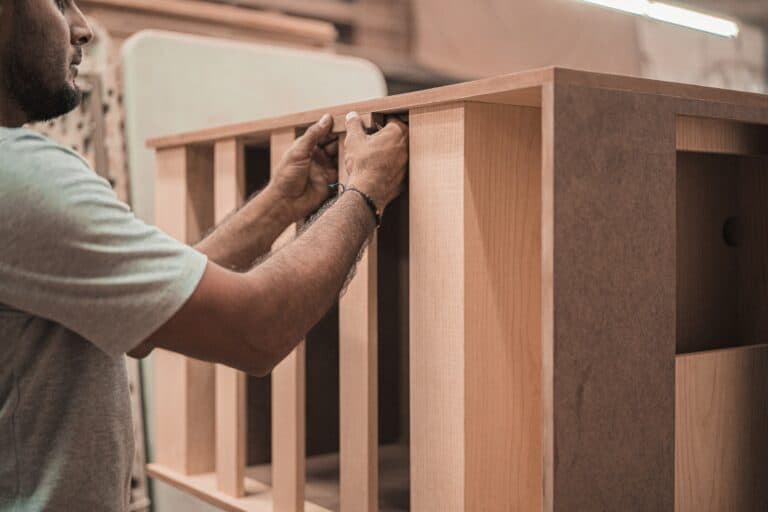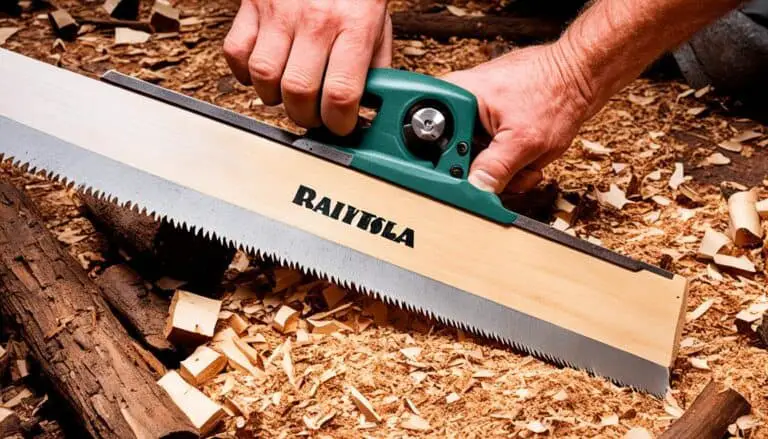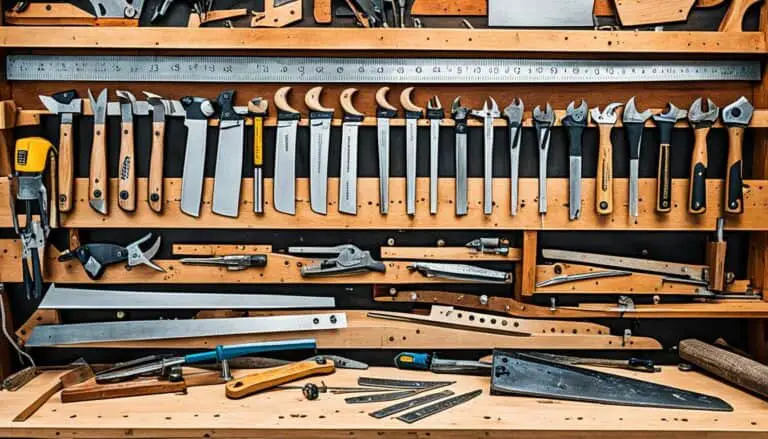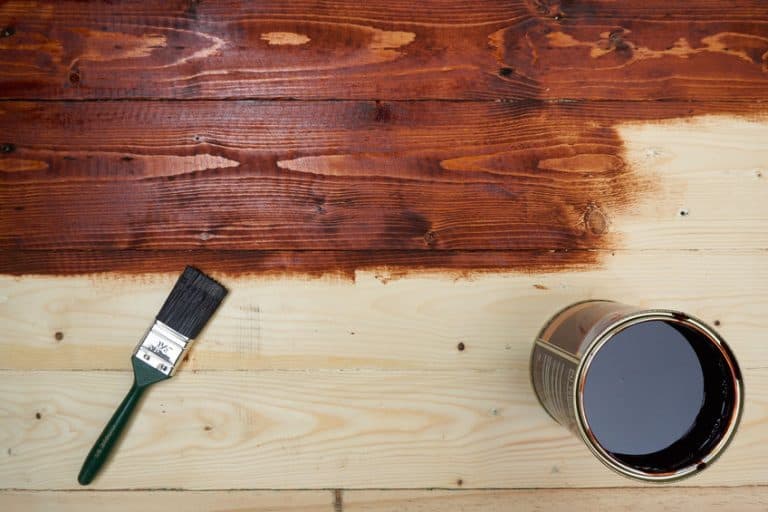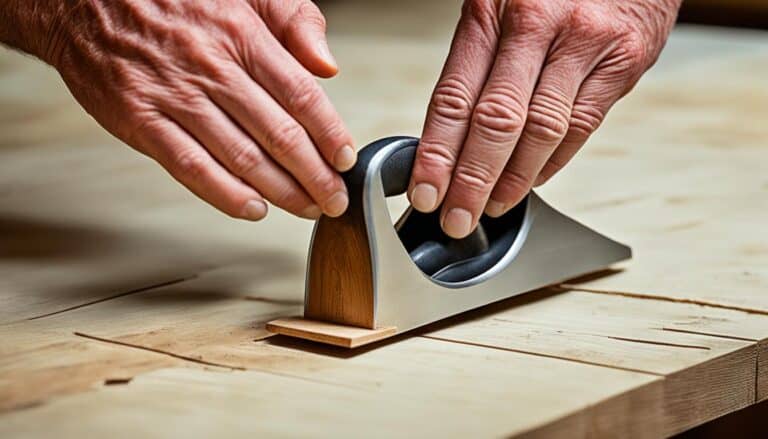Are you ready to take your woodworking skills to the next level? Whether you’re a beginner or an experienced woodworker, learning essential woodworking techniques is crucial for creating beautiful and professional-quality projects. From mastering milling to perfecting jointing and planing, these fundamental techniques will not only improve the quality of your work but also enhance your overall woodworking experience.
In this comprehensive guide, we will explore a wide range of woodworking techniques, covering everything from milling and sawing to drilling and shaping. You will discover the importance of each technique and learn valuable tips and tricks to ensure success in your woodworking projects. Whether you’re interested in creating furniture, woodworking crafts, or even pursuing woodworking as a career, this guide will equip you with the essential knowledge and skills to excel in the craft.
Are you ready to unlock the secrets of woodworking techniques that will elevate your skills to new heights? Let’s dive in!
Key Takeaways:
- Mastering essential woodworking techniques is crucial for creating professional-quality projects.
- Understanding milling, jointing, planing, and sawing techniques lays the foundation for successful woodworking.
- Drilling, routing, gluing, and shaping techniques add versatility and precision to your woodworking projects.
- Sanding, filing, and utilizing the right woodworking tools are essential for achieving a smooth and polished finish.
- Woodworking offers endless possibilities as a hobby and a rewarding career path, with opportunities for creativity and skill development.
The Importance of Milling in Woodworking
Milling is a crucial process in woodworking that involves transforming rough lumber into geometrically precise blocks. By meticulously shaping and smoothing the wood, milling prepares it for joinery and enhances the overall quality of woodworking projects.
GREAT GIFT IDEAS!
To achieve the desired results, the milling process typically includes three key steps:
- Flattening with a jointer: A jointer is used to flatten one face of the rough lumber, ensuring a level and smooth surface for further processing. This step is essential in creating a stable foundation for precise woodworking.
- Smoothing with a planer: After flattening, the opposite face of the lumber is smoothed using a planer. This removes any inconsistencies and imperfections, resulting in a uniform and refined surface.
- Cutting parallel with a table saw: The remaining edge of the lumber is cut parallel to the flattened face using a table saw. This step ensures that the wood blocks have uniform dimensions and can be easily joined together.
By transforming rough lumber into precisely milled blocks, woodworking enthusiasts and professionals can achieve tighter joinery, enhanced structural integrity, and a more professional finish. Milling is a fundamental technique that lays the foundation for creating exquisite woodwork.
| Advantages of Milling in Woodworking | Examples |
|---|---|
| Precision: Milling ensures the creation of geometrically accurate wooden blocks, allowing for seamless fitting and assembly. | A dovetail joint with perfectly milled and shaped blocks. |
| Improved stability: Properly milled wood blocks result in sturdy and durable furniture and structures that can withstand the test of time. | A solid dining table with accurately milled legs and supports. |
| Efficient joinery: Precisely milled blocks enable tighter and more secure joinery techniques such as mortise and tenon joints. | A cabinet with intricate joinery showcasing the precision of milling. |
| Aesthetically pleasing results: Milling ensures a consistent and smooth surface finish, enhancing the visual appeal of woodworking projects. | A wooden picture frame with exquisitely milled edges and corners. |
Jointing and Planing Techniques in Woodworking
In woodworking, jointing and planing are essential techniques for achieving flat surfaces and creating strong, angled joints. Jointing involves preparing the edges of wooden boards for gluing or joining them to other boards, while planing is used to smooth surfaces and remove excess material. Let’s explore these techniques in more detail.
Jointing:
In jointing, the goal is to flatten and square the edges of wooden boards. This process ensures that the jointed edges fit perfectly when glued together or joined with other boards. Jointing is crucial for creating strong and seamless connections between wooden pieces. It also helps in aligning boards for a smooth and even surface. Typically, jointing is done using a jointer machine, which has a rotating cutterhead and a stationary fence. The boards are guided against the fence while the cutterhead removes any irregularities and creates a flat edge.
Jointing can also be done using hand tools, such as a hand plane or a hand jointer. While hand jointing requires more skill and effort, it can be a viable option for smaller projects or when a jointer machine is not available.
Planing:
Planing, on the other hand, is used to smooth wooden surfaces and remove any excess material. It is an essential technique for achieving a professional finish on woodworking projects. Planing can be done with a hand plane or a powered planer machine.
When using a hand plane, the woodworker applies controlled pressure and carefully moves the plane across the surface of the wood. This process creates a smooth and even surface by shaving off thin layers of wood. Hand planing allows for precision and control, especially when working on smaller or intricate areas.
A powered planer machine, also known as a thickness planer, is a time-saving tool that efficiently removes material from larger workpieces. It consists of a rotating cutterhead and a motor that feeds the wood through the machine at a consistent thickness. This ensures that all surfaces are parallel and uniform.
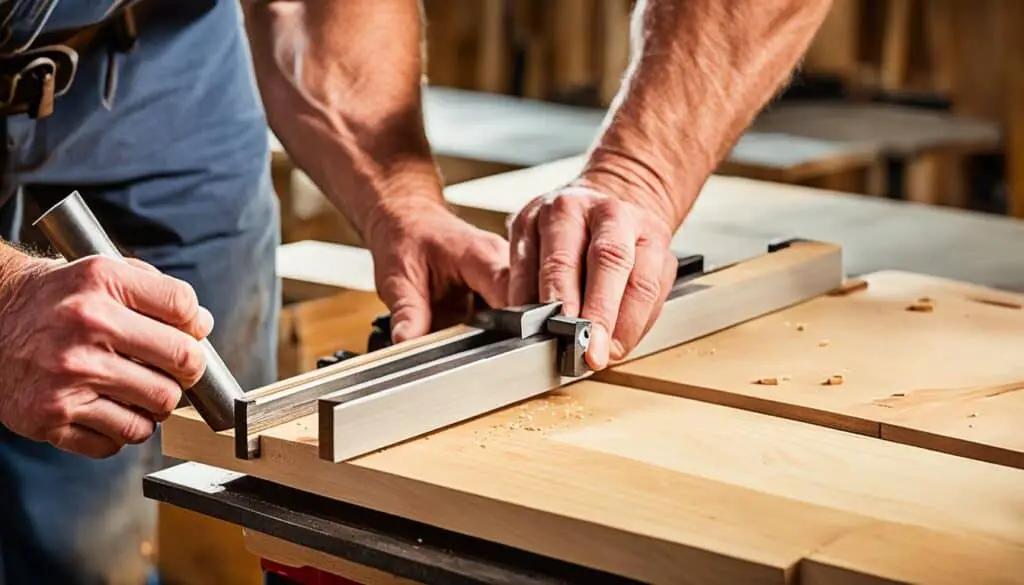
By combining jointing and planing techniques, woodworkers can achieve flat and smooth surfaces while removing any imperfections or excess material. Whether it’s preparing boards for joinery or creating a polished finish, these techniques play a vital role in woodworking projects.
The Importance of Sawing in Woodworking
Sawing is an essential step in almost every woodworking project. It involves cutting down wood using different types of saws to shape and form the desired pieces. Whether you’re a beginner or an experienced woodworker, understanding the importance of sawing and using the right saw for the job is crucial for successful woodworking.
When working with saws, it’s essential to prioritize safety measures. Always wear safety glasses and hearing protection to protect your eyes and ears from potential hazards. Additionally, ensure you have a clear workspace and maintain a stable footing to prevent accidents.
There are various types of saws available for different cutting needs in woodworking:
- Chop Saws: These powerful saws are commonly used for rough cuts, such as cutting large pieces of lumber or trimming wood to approximate lengths.
- Hand Saws: Hand saws are portable and versatile tools that allow you to make precise cuts. They are ideal for cutting boards, making joinery, or creating detailed shapes and designs.
- Table Saws: Table saws are stationary and offer excellent precision. They are commonly used for making straight cuts, ripping boards, and creating precise angles. It is essential to follow all safety precautions when operating a table saw.
Each type of saw serves a specific purpose, so it’s crucial to select the appropriate saw for the task at hand. By using the right saw, you can achieve clean and accurate cuts, making your woodworking projects visually appealing and structurally sound.
Remember, proper safety measures and the right choice of saw are the keys to successful sawing in woodworking. Take your time, practice, and familiarize yourself with different saws to master this fundamental skill.
The Importance of Sawing:
“Sawing is an essential step in woodworking that allows you to shape and form wood into desired pieces. By understanding the different types of saws and following safety measures, you can make precise cuts and create beautiful woodwork projects.” – Woodworking Expert
Mastering Drilling and Boring in Woodworking
Drilling and boring are essential techniques in woodworking that allow you to create holes, modify existing holes, and remove material with precision. Whether you’re working on a small home project or a larger construction, understanding the basics of drilling and boring is crucial.
Drilling: Creating Holes
Drilling involves the process of creating holes in wood using a drill and drill bits. The drill bit size and type depend on the desired hole size and the material being drilled. For smaller holes, twist drill bits are commonly used, while for larger holes, spade or paddle bits may be more appropriate.
Remember: Always wear safety glasses and secure your workpiece firmly before drilling to prevent accidents.
Boring: Enlarging Holes and Removing Material
Boring is the technique used to enlarge existing holes or remove material. It is often performed after drilling to achieve the desired hole size or shape. Boring can be done with specialized tools such as auger bits, which have a screw-like tip for easier penetration into the wood.
Pro Tip: To achieve clean and precise holes, mark the center point of the hole and use a center punch to create a small indentation before drilling or boring.
Choosing the Right Drill Bit
The selection of the appropriate drill bit depends on the project requirements. Consider the following factors:
- Material: Different materials require different drill bits. For example, wood, metal, and masonry each have specific drill bit types designed for optimal performance.
- Hole Size: The desired hole size determines the drill bit diameter. Measure the diameter accurately to ensure a proper fit for screws or other fasteners.
- Bit Type: There are various types of drill bits available, including twist, paddle, spade, and auger bits. Each bit type is designed for specific drilling applications.
Pro Tip: It’s always a good idea to have a range of drill bits in different sizes and types to meet the needs of various woodworking projects.
The Drill Press Advantage
A drill press is a powerful tool that provides more precision and control compared to handheld drills. It is often used in professional woodworking shops but can also be beneficial for serious hobbyists.
Pro Tip: A drill press with adjustable speed settings allows you to adapt to different materials and drilling depths for a more versatile woodworking experience.
In contrast, handheld drills offer portability and convenience, making them ideal for smaller projects or when mobility is essential.

“Drilling and boring are foundational techniques in woodworking. Mastering these skills will open up new possibilities for your woodworking projects.”
The Role of Routing in Woodworking
Routing is an essential technique in woodworking that allows you to shape, cut, and trim wood to create finished edges and intricate designs. By using a router, whether handheld or mounted on a table, you can achieve precise and professional-looking results. Let’s explore the various ways routing can enhance your woodworking projects.
Shaping Wood
One of the primary uses of routing is shaping wood. With a router bit specifically designed for shaping, you can create smooth curves, chamfers, and decorative profiles on your workpiece. The versatility of routing allows you to unleash your creativity and bring unique designs to life.
Trimming
When working with large wooden panels or doors, routing can be used for trimming. By running a flush trim bit along the edge, you can ensure that all the edges are uniform and smooth, resulting in a professional finish.
Creating Grooves
Routing is also commonly used for creating grooves or dadoes in wood. These grooves are ideal for inserting wooden panels, creating joints, or adding decorative elements to your projects. By selecting the appropriate router bit, you can achieve precise and accurate grooves.
Edge Treatments
Adding edge treatments is another area where routing excels. By using router bits with different profiles, you can create decorative edges, such as ogees, ovolos, or coves, that elevate the visual appeal of your woodworking projects. Whether you want clean and simple edges or ornate details, routing allows you to achieve the desired effect.
“Routing is a versatile technique that enables woodworkers to unleash their creativity and enhance the quality of their projects. From shaping wood to creating grooves and adding decorative edges, routing offers endless possibilities.”
Routing is a valued technique in woodworking due to its versatility and ability to enhance the overall quality of your projects. Whether you are a beginner or an experienced woodworker, incorporating routing into your woodworking repertoire will allow you to take your craftsmanship to the next level.
Gluing and Clamping in Woodworking
Gluing and clamping are essential techniques in woodworking that allow you to join multiple pieces of wood together securely. When done correctly, gluing provides a strong bond that ensures the durability and stability of your woodworking projects. Clamps, on the other hand, are invaluable tools that hold the pieces in place while the glue dries, ensuring a tight and even connection.
There are different types of glue commonly used in woodworking, each with its own unique properties and recommended applications. The three main types of glue are:
- White and yellow interior glue: These glues are commonly used for general woodworking projects. They dry clear and are easy to work with.
- Exterior glue: Designed for outdoor projects, this glue is resistant to moisture and weather conditions, making it ideal for applications exposed to the elements.
- Epoxy: Epoxy glue is incredibly strong and creates a durable bond. It is often used for bonding materials with different characteristics, such as wood and metal.
- Bar clamps: These clamps consist of a long bar or rail with adjustable clamping jaws. They are versatile and can exert significant pressure, making them suitable for various woodworking tasks.
- Pipe clamps: Pipe clamps utilize pipe lengths and threaded connectors to create adjustable clamping setups. They are cost-effective and provide ample clamping capacity.
- F-clamps: F-clamps have a fixed jaw and a sliding jaw, which can be adjusted using a threaded handle. They are lightweight, easy to use, and ideal for smaller projects.
Whether you are bonding small pieces or assembling larger structures, having the right glue and clamps for the job is crucial. By choosing the appropriate materials and using quality gluing and clamping techniques, you can ensure the strength and longevity of your woodworking projects.
Pro Tips:
“Before applying glue, ensure that the surfaces are clean, dry, and free from dust or debris. This will help achieve a better bond.”
“To prevent excess glue from spreading onto the surrounding wood, use masking tape or painter’s tape to mask off the areas you don’t want the glue to reach.”
Remember, gluing and clamping are essential steps in the woodworking process that should never be rushed. Take the time to select the right glue and clamp for your project and ensure proper drying time according to the glue manufacturer’s instructions. This will help you achieve strong, reliable joints that will withstand the test of time.
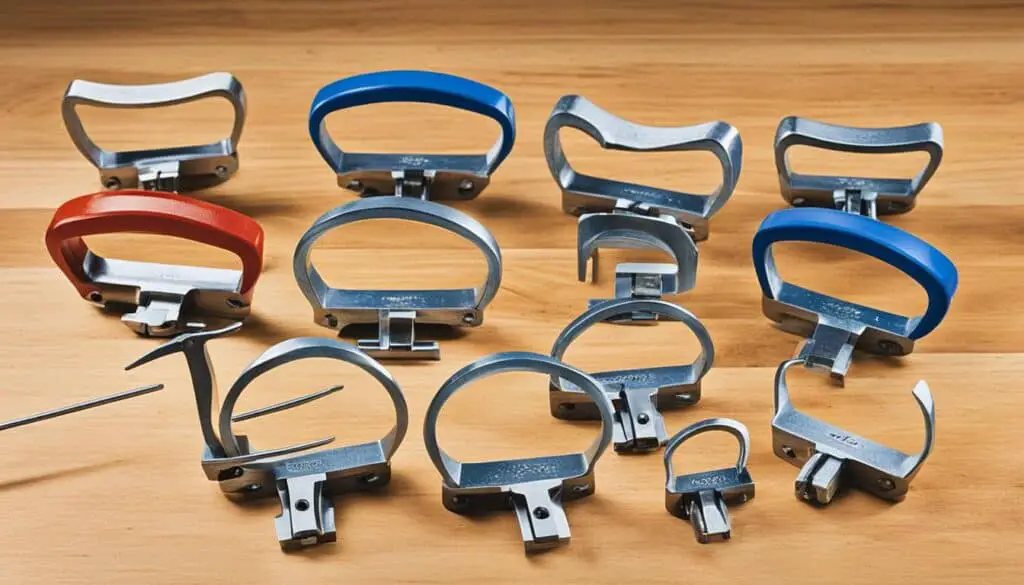
Shaping and Molding Techniques in Woodworking
When it comes to woodworking, shaping and molding techniques allow you to transform wood into intricate and unique designs. Whether you’re looking to add decorative elements or create non-rectangular shapes, these techniques provide endless creative possibilities.
Shaping:
Shaping involves carving wood into non-rectangular forms, adding depth and dimension to your projects. From organic curves to abstract designs, shaping allows you to create one-of-a-kind pieces that showcase your craftsmanship. One popular tool for shaping is the scroll saw, which enables you to cut intricate patterns and designs with precision. Whether you’re crafting delicate scrollwork or bold artistic statements, the scroll saw is a versatile tool that no woodworker should be without.
Molding:
Molding refers to strips of wood used for decorative profiles on furniture, cabinetry, and architectural elements. By adding molding to your projects, you can bring visual interest and elegance to any piece. There are various styles of molding to choose from, ranging from simple and understated to ornate and intricate. Whether you’re creating a classic crown molding or an intricate baseboard, molding adds sophistication and detail to your woodworking projects.
Lathe Turning:
Lathe turning is a technique that allows you to shape wood into cylindrical forms like table legs, bowls, and vases. Using a lathe machine, you can rotate the wood while cutting and shaping it with various tools. This method provides precise control over the shape and dimensions of your turned pieces, allowing you to create symmetrical and visually pleasing designs. Whether you’re a beginner or an experienced woodworker, lathe turning is a rewarding technique that adds a new dimension to your woodworking skills.
Veneering:
Veneering involves gluing thin slices of wood, known as veneers, to the surface of a solid piece. This technique allows you to create intricate patterns and designs using different wood species. Veneering not only enhances the aesthetic appeal of your projects but also adds strength and stability to the wood. Whether you’re creating a tabletop with a stunning marquetry design or adding a veneer to a cabinet door for a sleek look, veneering opens up a world of possibilities for customization.
Lamination:
Lamination is a technique in which layers of wood are bonded together with glue and pressure to create a strong and stable composite material. It allows you to combine different wood species, colors, and textures to achieve unique visual effects. Laminated wood is highly resistant to warping and splitting, making it an excellent choice for tabletops, countertops, and work surfaces. With lamination, you can create stunning combinations of wood that highlight the natural beauty of each species.
| Technique | Description |
|---|---|
| Shaping | Carving wood into non-rectangular forms using tools like the scroll saw |
| Molding | Adding decorative profiles to wood pieces for enhanced visual appeal |
| Lathe Turning | Shaping wood into cylindrical forms using a lathe machine |
| Veneering | Gluing thin slices of wood to the surface of a solid piece |
| Lamination | Bonding layers of wood together to create a strong and stable composite material |
These shaping and molding techniques offer a wealth of opportunities for creativity and expression in woodworking. Whether you’re a beginner or an experienced woodworker, incorporating these techniques into your projects will elevate the craftsmanship and aesthetic appeal of your work.
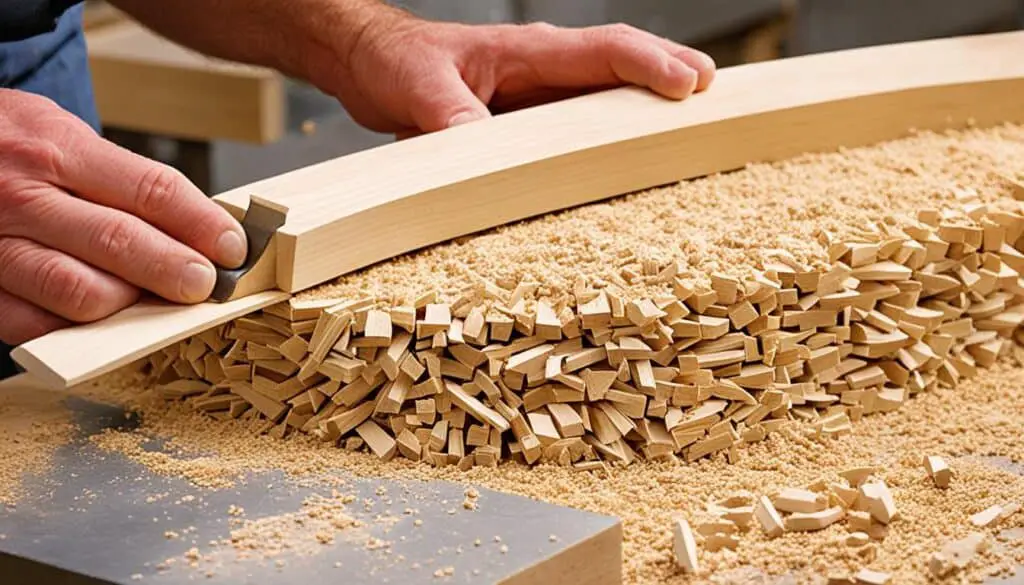
Sanding and Filing Techniques in Woodworking
In woodworking, sanding and filing are crucial techniques for achieving smooth and refined surfaces. Whether you’re working on a small project or a larger surface, understanding the different methods and tools for sanding and filing will help you achieve professional-looking results.
Sanding Techniques
Sanding involves using sandpaper to remove imperfections, smooth rough areas, and prepare the wood for finishing. There are two main types of sanding: hand sanding and powered sanding.
“Sanding gives your woodworking projects a polished and professional look.”
Hand sanding is typically done using a sanding block or by wrapping sandpaper around your hand. It allows for better control and precision, making it ideal for small details and delicate surfaces.
Powered sanding tools, such as disc sanders and spindle sanders, are used for larger surfaces and shaping. They provide faster and more efficient results, especially when working with larger pieces of wood.
Filing Techniques
Filing is a technique used to shape wood and remove rough spots. It involves using files or rasps, which are handheld tools with abrasive surfaces.
Files have rows of small teeth that gradually remove material as you push the file across the wood. They are ideal for shaping and smoothing edges, creating bevels, and adjusting curves.
Rasps, on the other hand, have larger, more aggressive teeth, making them suitable for rapid material removal and rough shaping.
Sandpaper Grits
Sandpaper comes in various grits, which determine its level of coarseness. The higher the grit number, the finer the sandpaper. Different grits are used at different stages to achieve the desired smoothness.
| Grit Range | Common Uses |
|---|---|
| Coarse (40-80) | Removes material quickly, smooths rough surfaces |
| Medium (100-150) | Refines surfaces, removes previous sanding marks |
| Fine (180-220) | Prepares wood for finishing, smoothens rough spots |
| Extra Fine (240-400) | Creates a polished surface, removes fine scratches |
By using a progression of sandpaper grits, starting with a coarser grit and gradually moving to finer grits, you can achieve a smooth and flawless surface.
Remember, sanding and filing are important steps in the woodworking process that should not be overlooked. They allow you to create a foundation for a beautiful finish and ensure your woodworking projects are visually appealing and comfortable to the touch.
Introduction to Woodworking Tools
Woodworking tools are essential for cutting, shaping, joining, and finishing wood projects. Whether you’re a beginner or a seasoned woodworker, having the right tools is crucial for achieving precise and professional results. Understanding the different types of tools available and their specific functions will help you select the right ones for your projects.
Saws
Saws are primary woodworking tools used for cutting wood into various shapes and sizes. There are different types of saws available, each designed for specific cutting tasks:
| Saw Type | Description |
|---|---|
| Hand Saw | A versatile saw used for general-purpose cutting and precision work. |
| Table Saw | Provides accurate and controlled cuts, ideal for ripping large pieces of wood. |
| Circular Saw | A portable saw often used for cross-cutting and making straight cuts. |
| Jigsaw | Perfect for cutting curves and irregular shapes in wood. |
Drills
Drills are necessary for creating holes in wood and driving screws or other fasteners:
- Handheld Drill: Portable and versatile, suitable for most drilling tasks.
- Drill Press: Provides precision drilling with adjustable speed and accurate depth control.
Clamps
Clamps are used to hold wood pieces together while glue sets or while other woodworking operations are being performed. Here are some common types of clamps:
- Bar Clamps: Ideal for large-scale projects and providing even pressure.
- Pipe Clamps: Used for heavy-duty clamping with long lengths of pipe.
- F-Clamps: Versatile and easy to use, providing strong and secure clamping.
Chisels
Chisels are hand tools used for shaping, carving, and removing wood material. They are available in various sizes and shapes to accommodate different woodworking needs.
Planers
A planer is a powerful tool used for smoothing, flattening, and resizing wooden surfaces. It removes thin layers of wood to create uniform thickness.
Sanders
Sanders are essential for achieving smooth and polished surfaces. There are different types of sanders available:
- Orbital Sander: Suitable for general sanding and creating a smooth finish.
- Belt Sander: Used for fast material removal and leveling uneven surfaces.
- Random Orbital Sander: Combines the advantages of orbital and belt sanders, providing efficient sanding with minimal swirl marks.
Having a well-equipped toolbox ensures that you have the right woodworking tools at your disposal for any project. Invest in quality tools that will last long and deliver precise results. By understanding the functions and uses of different woodworking tools, you can enhance your skills and create beautiful woodwork projects.
Woodworking as a Career
If you have a passion for woodworking, why not turn it into a fulfilling career? Professional woodworkers have the opportunity to design and create beautiful wooden objects that can range from cabinets and furniture to musical instruments. By honing your skills and expertise, you can turn your love for woodworking into a successful and rewarding career.
There are various pathways to pursue a career in woodworking. One option is to enroll in credential programs that provide comprehensive training in woodworking techniques, safety measures, and project management. These programs offer hands-on learning experiences and equip you with the skills needed to excel in the industry.
Another option is to seek apprenticeships with experienced woodworkers. Apprenticeships provide invaluable mentorship and allow you to learn directly from seasoned professionals. Through hands-on training and real-world projects, apprenticeships can fast-track your learning and help you develop the necessary skills to succeed in the woodworking industry.
Woodworking offers a wide range of career opportunities. You can choose to work for established woodworking companies, where you can contribute to large-scale projects and collaborate with other professionals. Alternatively, you can start your own woodworking business, giving you the freedom to pursue your creative vision and showcase your craftsmanship.
As a professional woodworker, you have the chance to work with various clients, including individuals, businesses, and even museums. This allows you to create custom pieces, restore antique furniture, or contribute to architectural projects, among other possibilities.
Beyond the technical skills required for woodworking, it’s also important to develop business acumen. Running a woodworking business involves managing finances, marketing your services, and building a strong client base. By mastering both the craft and the business side of woodworking, you can thrive in this dynamic industry.
Woodworking Career Paths
Here are some potential career paths within the field of woodworking:
| Career Path | Description |
|---|---|
| Cabinet Making | Create custom cabinets for residential or commercial projects, working with different wood types and finishes. |
| Furniture Design and Build | Design and construct unique and high-quality furniture pieces, ranging from contemporary to traditional styles. |
| Instrument Making | Specialize in crafting musical instruments, such as guitars, violins, or drums, with precision and attention to detail. |
| Artisan Woodworking | Create one-of-a-kind wooden objects, sculptures, or artworks, combining artistic flair with woodworking skills. |
| Restoration and Repair | Repair and restore antique or damaged wooden furniture, preserving their historical significance and beauty. |
| Architectural Woodworking | Collaborate with architects and contractors to create custom woodwork for residential and commercial buildings. |
Embarking on a woodworking career allows you to work with your hands, unleash your creativity, and create tangible masterpieces. With the right training, experience, and passion, you can carve out a successful career in this timeless craft.
How to Start Woodworking
Starting woodworking is an exciting journey that allows you to create beautiful and functional pieces of art. Whether you want to pursue it as a hobby or a potential career, learning the fundamentals and techniques is essential for success. Here’s how you can begin your woodworking journey:
1. Understand Safety Measures
Before you start woodworking, it’s crucial to prioritize safety. Familiarize yourself with basic safety practices, such as wearing protective goggles, ear protection, and proper clothing. Learn how to handle woodworking tools and machinery safely to prevent accidents.
2. Acquire Essential Tools
To get started, you’ll need a set of essential woodworking tools. Invest in high-quality hand tools like chisels, a mallet, a coping saw, and a set of carving gouges. Additionally, power tools such as a circular saw, a drill, and a random orbital sander will enhance your capabilities. Start with a basic tool set and gradually expand as you progress in your woodworking skills.
3. Start with Small, Simple Projects
When beginning woodworking, it’s important not to overwhelm yourself with complex projects. Start with small, simple projects like a cutting board, a birdhouse, or a picture frame. These projects will allow you to practice basic techniques and build your confidence as you progress.
4. Learn from Experienced Woodworkers
Learning from experienced woodworkers can significantly accelerate your skill development. Seek out opportunities to connect with local woodworking communities or enroll in woodworking classes and workshops. Interacting with experienced woodworkers will provide valuable guidance, insights, and mentorship.
5. Take Woodworking Classes
Woodworking classes are an excellent way to learn new techniques, gain hands-on experience, and expand your knowledge. Look for reputable woodworking schools or community colleges that offer woodworking classes. These classes often cover various topics such as joinery, furniture making, and finishing techniques.
6. Practice Consistently
Consistency is key in improving your woodworking skills. Set aside regular time in your schedule for woodworking practice and make it a habit to work on projects or practice new techniques. The more you practice, the more refined your skills will become.
Remember, woodworking is a journey that requires patience and dedication. As you continue to learn and hone your skills, you’ll be able to tackle more complex projects and create stunning pieces of craftsmanship.
| Benefits of Starting Woodworking | Benefits of Joining Woodworking Classes |
|---|---|
|
|
Whether you choose to start woodworking on your own or with the guidance of woodworking classes, remember to be patient with yourself. Celebrate every small accomplishment as you gain confidence and refine your skills. With dedication and passion, you can embark on a fulfilling woodworking journey.
Learning Woodworking at The Crucible
If you’re interested in mastering woodworking techniques and expanding your woodworking skills, look no further than The Crucible. They offer a wide range of woodworking classes and workshops tailored to beginners and experienced woodworkers alike. Whether you’re just starting out or looking to refine your expertise, The Crucible provides a supportive and educational environment for you to learn and grow.
At The Crucible, you’ll have the opportunity to learn from experienced instructors who are passionate about sharing their knowledge and expertise. They will guide you through various woodworking techniques, from using hand tools to operating power tools. Each class and workshop is carefully designed to provide hands-on experience, allowing you to work on your own projects while receiving guidance and feedback from the instructors.
Woodworking classes at The Crucible cover a wide range of topics, including:
- Introduction to woodworking tools
- Joinery techniques
- Finishing and staining
- Woodturning
- Cabinetmaking
Whether you’re interested in building furniture, creating intricate woodturnings, or exploring the art of cabinetry, The Crucible has a class or workshop to suit your interests and skill level. They provide a supportive and collaborative learning environment where you can connect with fellow woodworking enthusiasts and share your passion for the craft.
By taking part in woodworking classes at The Crucible, you’ll not only gain valuable woodworking skills, but also become part of a vibrant woodworking community. You’ll have the opportunity to connect with like-minded individuals who share your passion and enthusiasm for woodworking. The Crucible is dedicated to fostering a strong community of makers and artists, and their woodworking classes are a testament to their commitment.
Woodworking Classes at The Crucible
| Class | Description | Duration |
|---|---|---|
| Introduction to Woodworking | Learn the basics of woodworking, including tool usage, joinery techniques, and project construction. | 4 weeks |
| Advanced Cabinetry | Build on your woodworking skills and learn advanced techniques in cabinetry and furniture making. | 8 weeks |
| Woodturning Masterclass | Discover the art of woodturning and create intricate woodturnings using a lathe. | 6 weeks |
| Finishing and Staining Techniques | Learn how to finish and stain your woodworking projects for a professional and polished look. | 2 weeks |
Whether you’re looking to pursue woodworking as a hobby or considering a woodworking career, The Crucible’s woodworking classes and workshops provide a solid foundation for your woodworking journey. With expert instruction, hands-on experience, and a supportive community, you’ll have the opportunity to enhance your skills and create beautiful, handcrafted pieces.
Woodworking FAQs
Woodworking FAQs provide answers to common questions about woodworking. Whether you’re a beginner or an experienced woodworker, it’s important to have a clear understanding of key aspects related to this craft. Below, we address some frequently asked questions to help you gain valuable insight into woodworking:
1. What is the difference between woodworking and carpentry?
Woodworking focuses on creating objects and structures from wood, such as furniture, cabinets, and decorative items. Carpentry, on the other hand, involves constructing and installing wooden structures, such as houses, roofs, and framing. While both involve working with wood, woodworking is typically more artistic and intricate, while carpentry leans towards practical construction.
2. What is the potential income as a woodworker?
The income as a woodworker varies depending on factors such as skill level, experience, and location. Entry-level woodworking positions or self-employed woodworking ventures may have lower incomes, while experienced professionals can earn a substantial income. According to the U.S. Bureau of Labor Statistics, the median annual wage for woodworkers was $34,880 in May 2020, with the highest 10% earning more than $53,040.
3. What is the cost of woodworking as a hobby?
The cost of woodworking as a hobby can vary based on individual preferences and project requirements. Initial investments include purchasing essential tools, such as a saw, drill, chisels, and sanders. Additionally, the cost of materials, such as wood and finishing supplies, should be considered. It is possible to start woodworking on a budget by acquiring basic tools and selecting cost-effective materials.
4. How can I set up a woodworking workshop at home?
Setting up a woodworking workshop at home requires careful planning and organization. Consider the following key aspects:
- Designating a dedicated space that is well-ventilated and equipped with proper lighting.
- Acquiring essential woodworking tools and equipment, ensuring they are properly stored.
- Installing a sturdy workbench for cutting, shaping, and assembling wood.
- Arranging storage solutions for wood stock, hardware, and safety equipment.
- Implementing safety measures, such as fire prevention and dust collection systems.
By creating a functional and safe woodworking workshop at home, you can pursue your woodworking passion conveniently and efficiently.
Summary
Woodworking FAQs provide valuable information for beginners and enthusiasts seeking answers to common questions. Understanding the difference between woodworking and carpentry, potential incomes, cost considerations, and setting up a home workshop are crucial elements to explore as you embark on your woodworking journey.
Conclusion
Woodworking is a versatile and rewarding craft that allows you to create beautiful woodwork projects. By mastering the essential woodworking techniques discussed in this guide, acquiring the right tools, and practicing consistently, you can elevate your woodworking skills to new heights. Whether you are pursuing woodworking as a hobby or a career, the knowledge and expertise gained from learning these techniques will serve as a solid foundation for your woodworking journey.
Throughout this guide, we have explored the importance of milling, jointing and planing, sawing, drilling and boring, routing, gluing and clamping, shaping and molding, sanding and filing, and the introduction to woodworking tools. These techniques form the backbone of woodworking, providing you with the ability to transform raw wood into intricate and functional pieces.
Whether you are a beginner or have some woodworking experience, continuously honing your skills and expanding your knowledge will unlock new possibilities and allow you to tackle more complex projects. Remember to prioritize safety at all times, wear appropriate protective gear, and follow best practices when working with tools and machinery.
In summary, woodworking is a craft that offers endless creativity and satisfaction. Embrace the learning process, practice patience, and let your passion for woodworking guide you as you embark on this fulfilling journey. With dedication and perseverance, you can create stunning pieces that showcase your skills and leave a lasting impression. Happy woodworking!
FAQ
What is milling in woodworking?
Milling is the process of transforming rough lumber into precise blocks for woodworking projects. It involves flattening one face of the lumber with a jointer, smoothing the opposite face with a planer, and cutting the remaining edge parallel with a table saw. Milling is essential for preparing wood for joinery.
What is the difference between jointing and planing in woodworking?
Jointing is the process of preparing the edges of wooden boards for gluing or joining them to other boards. It involves flattening and squaring the edges. Planing, on the other hand, is used to smooth wooden surfaces and remove excess material. Planing can be done with a planer machine or a hand tool.
Why is sawing important in woodworking?
Sawing is the initial step in almost every woodworking project. It involves cutting down wood using various types of saws. Safety precautions such as wearing safety glasses and hearing protection should always be followed when using saws. Different saws serve different purposes, such as chop saws for rough cuts, hand saws for portability, and table saws for precision cutting.
What is the difference between drilling and boring in woodworking?
Drilling involves creating holes in wood, while boring involves enlarging pre-existing holes by removing material. The selection of the proper drill bit depends on the desired hole size and the material being worked on. A drill press provides more precision and power, while handheld drills offer convenience.
What is routing used for in woodworking?
Routing is the process of shaping, cutting, and trimming wood to create finished edges and shapes. It involves using a router, which can be handheld or mounted on a table. Routers can be used for creating grooves, adding edge treatments, and following patterns. Routing is a versatile technique in woodworking.
What are the different types of glue used in woodworking?
There are three main types of glue commonly used in woodworking: white and yellow interior glue, exterior glue, and epoxy. Gluing is the process of joining two or more pieces of wood together using different types of glue. Clamps are essential for holding wood pieces together during glue drying. Different types of clamps, such as bar clamps, pipe clamps, and F-clamps, serve different purposes based on the size and scale of the project.
What are some shaping and molding techniques in woodworking?
Shaping involves carving wood into non-rectangular shapes, while molding refers to strips of wood used for decorative profiles. Scrollwork uses a scroll saw to create ornamental designs, while lathe turning shapes wood into cylindrical forms. Veneering involves gluing thin slices of wood to the surface of a solid piece, while lamination binds layers of wood together with glue and pressure.
How is sanding and filing used in woodworking?
Sanding is the process of smoothing the surface of wood using sandpaper. Hand sanding is commonly done with a block, while powered sanding tools such as disc sanders and spindle sanders are used for larger surfaces and shaping. Filing involves shaping wood and removing rough spots using files or rasps. Different grits of sandpaper are used for different levels of smoothness.
What are some essential woodworking tools?
Woodworking tools are essential for cutting, shaping, joining, and finishing wood projects. Common tools include saws, drills, clamps, chisels, planers, and sanders. The selection of tools depends on the specific project and the desired outcome.
What is woodworking as a career?
Woodworking can be pursued as a hobby or a full-blown career. Professional woodworkers design and build wooden objects such as cabinets, furniture, and musical instruments. There are credential programs and apprenticeships available for those interested in pursuing woodworking as a career.
How do you start woodworking?
Starting woodworking requires learning the fundamentals and techniques through classes or self-study. It is important to understand safety measures, acquire the essential tools, and start with small, simple projects. Learning from experienced woodworkers and taking classes can provide valuable guidance and skill development.
What can I learn at The Crucible for woodworking?
The Crucible offers woodworking classes and workshops that teach various woodworking techniques and skills. These classes cover everything from hand tools to power tools, allowing participants to create their own projects while learning from experienced instructors.
What are some common woodworking FAQs?
Woodworking FAQs address common questions related to woodworking, such as the difference between woodworking and carpentry, potential income as a woodworker, the cost of woodworking as a hobby, and setting up a woodworking workshop at home.














